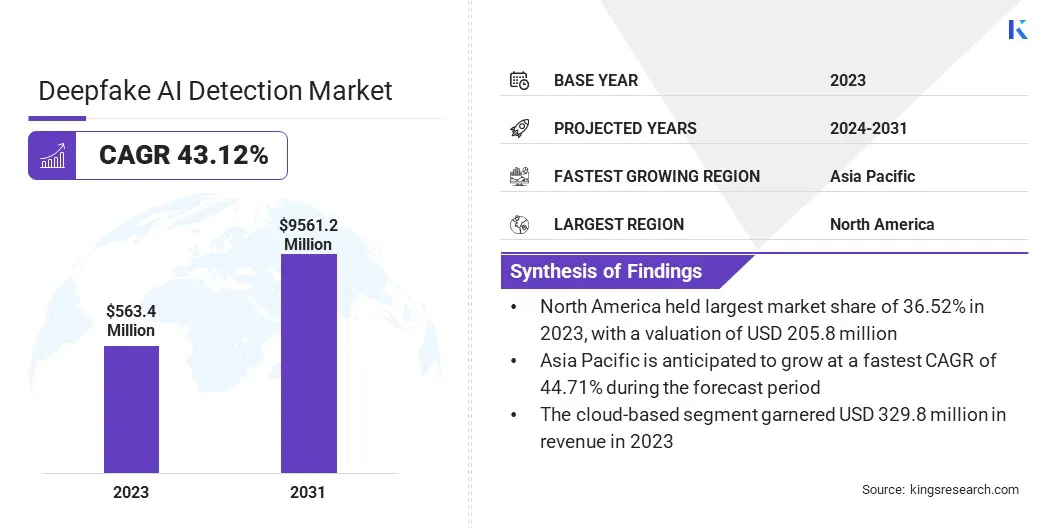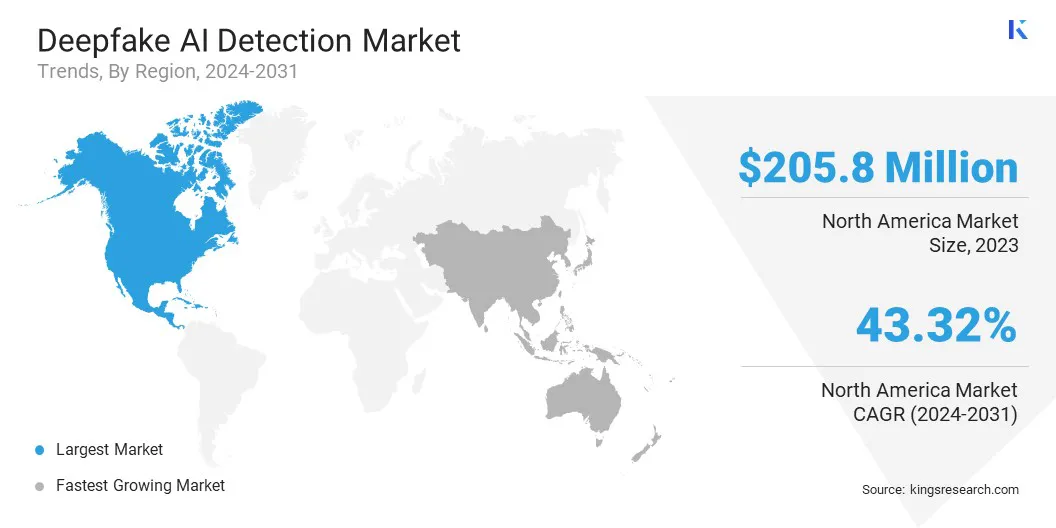Market Definition
The market focuses on technologies and solutions designed to identify and prevent deepfake content, including manipulated videos, images, or audio created using artificial intelligence. This market includes tools for detecting fake media in sectors like entertainment, politics, law enforcement, and cybersecurity to address concerns related to misinformation, security, and privacy.
Deepfake AI Detection Market Overview
Global deepfake AI detection market size was valued at USD 563.4 million in 2023, which is estimated to be valued at USD 777.2 million in 2024 and reach USD 9,561.2 million by 2031, growing at a CAGR of 43.12% from 2024 to 2031.
The rapid proliferation of AI-generated content across industries such as entertainment, marketing, and social media has increased the demand for robust content verification and authentication solutions.
As AI tools become more accessible and powerful, the risk of misinformation and digital manipulation has increased. This surge in risk is driving the need for effective deepfake detection technologies to safeguard content integrity and maintain trust.
Major companies operating in the deepfake AI detection industry are Pindrop Security, DuckDuckGoose B.V., Q-INTEGRITY, Sentinel, Sensity B.V., Attestiv Inc., deepware.ai, Arya.ai, Oz Forensics, Reality Defender Inc., Resemble AI, WeVerify, DeepBrain AI, Kroop AI, and BioID.
The market is evolving rapidly, driven by the increasing prevalence of AI-generated content and its potential misuse across various sectors. As deepfakes grow more sophisticated, the demand for advanced detection is increasing in industries like cybersecurity, media, and law enforcement.
With growing awareness of the risks posed by manipulated media, businesses and consumers are prioritizing tools that ensure content authenticity and protect against digital deception.
- In October 2024, Microsoft introduced the Content Integrity Suite, aimed at improving transparency in AI-generated media. The tool enables users to verify the authenticity of digital content by providing essential metadata to trace its origin and reduce the risk of manipulation.

Key Highlights:
- The deepfake AI detection industry size was recorded at USD 563.4 million in 2023.
- The market is projected to grow at a CAGR of 43.12% from 2024 to 2031.
- North America held a market share of 36.52% in 2023, with a valuation of USD 205.8 million.
- The video deepfake detection technology segment garnered USD 257.6 million in revenue in 2023.
- The cloud-based segment is expected to reach USD 5,724.7 million by 2031.
- The large enterprises segment held a market share of 57.88% in 2023
- The BFSI (Banking, Financial Services, and Insurance) segment is anticipated to have a CAGR of 45.43% during the forecast period.
- Asia Pacific is anticipated to grow at a CAGR of 44.71% during the forecast period.
What are the major factors driving market growth?
The rapid expansion of AI-generated content is a key growth driver for the deepfake AI detection market. With AI tools making it easier to create realistic videos, images, and audio, distinguishing genuine from manipulated media has become increasingly challenging.
This surge in AI content creation in entertainment, advertising, and social media is increasing the need for advanced detection systems for content authenticity.
- In August 2024, McAfee, in collaboration with Lenovo, launched the world’s first automatic AI-powered deepfake detector. The tool is designed to address the increasing prevalence of AI-generated content, offering consumers an efficient and privacy-focused solution to detect deceptive media and reduce the risk of scams.
What are the major obstacles for this market?
Data privacy concerns present a significant challenge in the deepfake AI detection market. Analyzing content for manipulation requires processing personal or sensitive media, increasing the risk of unauthorized access, data breaches, or misuse.
This has led to resistance among users and organizations regarding the adoption of detection tools due to potential privacy violations. To address this, developers are focusing on on-device processing, where analysis is conducted locally without transferring data to external servers.
Additionally, the implementation of robust encryption protocols and strict adherence to data protection regulations such as GDPR and CCPA can enhance trust.
Which technological trends are shaping the market?
Real-time detection capabilities are emerging as a pivotal trend in the market. This is due to the increasing demand for instant identification of manipulated media in live content and streaming environments. The widespread use of deepfakes across social media, news outlets, and live broadcasts has increased the need for rapid and accurate detection.
This demand is encouraging the development of advanced solutions that can analyze and verify content in real time to minimize the spread of misinformation, enabling swift response to deceptive media.
- In March 2025, Infibeam Avenues Ltd entered into a strategic Memorandum of Understanding (MoU) with the Indian Institute of Science (IISc), Bangalore, to collaboratively develop advanced real-time deepfake detection systems.
Deepfake AI Detection Market Report Snapshot
|
Segmentation
|
Details
|
|
By Type
|
Video Deepfake Detection, Image Deepfake Detection, Voice Deepfake Detection,
|
|
By Deployment Mode
|
Cloud-Based, On-Premises
|
|
By Enterprise Size
|
Small and Medium-Sized Enterprises (SMEs), Large Enterprises
|
|
By End-Use Industry
|
Media and Entertainment, BFSI (Banking, Financial Services, and Insurance), Government and Politics, Healthcare and Life Sciences, Others
|
|
By Region
|
North America: U.S., Canada, Mexico
|
|
Europe: France, U.K., Spain, Germany, Italy, Russia, Rest of Europe
|
|
Asia-Pacific: China, Japan, India, Australia, ASEAN, South Korea, Rest of Asia-Pacific
|
|
Middle East & Africa: Turkey, UAE, Saudi Arabia, South Africa, Rest of Middle East & Africa
|
|
South America: Brazil, Argentina, Rest of South America
|
Market Segmentation:
- By Type (Video Deepfake Detection, Image Deepfake Detection, Voice Deepfake Detection): The video deepfake detection segment earned USD 257.6 million in 2023 due to growing concerns over visual misinformation and security.
- By Deployment Mode (Cloud-Based, On-Premises): The cloud-based segment held 58.54% of the market in 2023, due to scalability, flexibility, and cost-effectiveness for AI deepfake detection solutions.
- By Enterprise Size (Small and Medium-Sized Enterprises (SMEs), Large Enterprises): The large enterprises segment is projected to reach USD 5,142.9 million by 2031, wing to greater investment in AI-driven security solutions.
- By End-Use Industry (Media and Entertainment, BFSI (Banking, Financial Services, and Insurance), Government and Politics, Healthcare and Life Sciences, Others): The BFSI segment is anticipated to have a CAGR of 45.43% during the forecast period, due to rising fraud prevention and risk management needs.
What is the market scenario in North America and Asia-Pacific region?
Based on region, the global market has been classified into North America, Europe, Asia Pacific, Middle East & Africa, and Latin America.

North America deepfake AI detection market share stood around 36.52% in 2023 in the global market, with a valuation of USD 205.8 million. North America holds a dominant position in the market, due to its high adoption of advanced technologies, superior AI capabilities, and significant demand for security and privacy solutions.
The presence of key players along with substantial investments in research, and development further enhances North America's leadership in the market. Additionally, the region’s well-established technological infrastructure supports the growth of deepfake detection solutions.
Growing concerns over cybersecurity, privacy violations, and deepfake-related threats in sectors such as media, entertainment, and government, continue to propel the demand for effective AI-based detection tools across North America.
- In May 2024, McAfee announced enhanced AI-powered deepfake detection technology at Rivest Shamir Adleman (RSA) Conference San Francisco, leveraging Intel Core Ultra processor’s NPU. This collaboration improves performance, privacy, and detection of AI-generated deepfakes. It also proves consumers with advanced local analysis for greater security.
Asia Pacific is anticipated to grow at a robust CAGR of 44.71% over the forecast period. Asia Pacific is emerging as the fastest-growing region in the deepfake AI detection industry, fueled by rapid digital transformation, increasing internet penetration, and a surge in AI adoption.
The region's growing concerns about online fraud, cybersecurity threats, and misinformation are prompting both governments and enterprises to invest in deepfake detection solutions.
Additionally, large-scale tech initiatives such as government-backed digital infrastructure projects and AI innovation programs are supporting the development and deployment of advanced detection tools. These factors are driving the growth of the market in the Asia Pacific region.
- In September 2024, Ensign InfoSecurity launched Aletheia, an AI-driven real-time deepfake detection solution in Asia. Aletheia provides up to 90% accuracy in detecting manipulated media, offering seamless protection via endpoint software or browser plug-in.
Regulatory Frameworks
- In the U.S., the Deceptive Audio or Visual Media ('Deepfakes') 2024 Legislation addresses the growing use of AI-driven deepfake technology, aiming to protect individuals from deceptive media.
- The EU General Data Protection Regulation (GDPR) governs how the personal data of individuals in the EU may be processed and transferred. It also includes guidelines on consent and data usage for AI models.
- In India, the Information Technology (Intermediary Guidelines and Digital Media Ethics Code) Rules, 2021 regulate social media platforms, requiring compliance officers, content monitoring, grievance mechanisms, and originator identification, raising concerns about privacy and free speech.
Competitive Landscape
Strategic investments in the deepfake AI detection industry are rising as companies focus on advancing AI and machine learning technologies. These investments target real-time detection, improved accuracy, and scalable solutions.
Partnerships with academic institutions and cybersecurity firms further drive innovation, aiming to combat misinformation, fraud, and security risks associated with deepfake technology across various sectors.
- In October 2024, Accenture made a strategic investment in Reality Defender, an AI-powered deepfake detection company. This investment enhances Accenture's cybersecurity offerings, providing enterprises and governments with advanced tools to detect and prevent deepfake fraud, disinformation, and cybercrime in real-time.
List of Key Companies in Deepfake AI Detection Market:
- Pindrop Security
- DuckDuckGoose B.V.
- Q-INTEGRITY
- Sentinel
- Sensity B.V.
- Attestiv Inc.
- Oz Forensics
- Reality Defender Inc.
- Resemble AI
- WeVerify
- DeepBrain AI
- Kroop AI
- BioID
Recent Developments (Partnerships/New Product Launch)
- In March 2025, Reality Defender strengthened its voice deepfake detection capabilities through a strategic partnership with ElevenLabs. This collaboration enhanced training datasets, improved model accuracy, and expanded multi-language support, significantly advancing the ability to detect synthetic voice content. These developments set new industry benchmarks in combating AI-driven threats
- In December 2024, Hive secured a Department of Defense (DoD) contract to enhance deepfake detection capabilities across video, image, and audio content. This collaboration strengthens national security efforts by utilizing Hive's advanced AI models to combat synthetic media and safeguard against AI-driven disinformation threats
- In September 2024, YouTube introduced new tools to protect creators from AI-generated content misuse. These include synthetic-singing identification and face detection technologies, enabling creators to manage AI simulations of their likeness. YouTube aims to enhance creator control while maintaining responsible AI development for a secure, creative environment
- In June 2024, LatticeFlow AI launched the LatticeFlow AI Audio, designed to address the growing need for deepfake detection solutions. This product focuses on detecting audio-based deepfakes and offers an advanced, multi-modal solution to counter the increasing risks of synthetic media manipulation.


